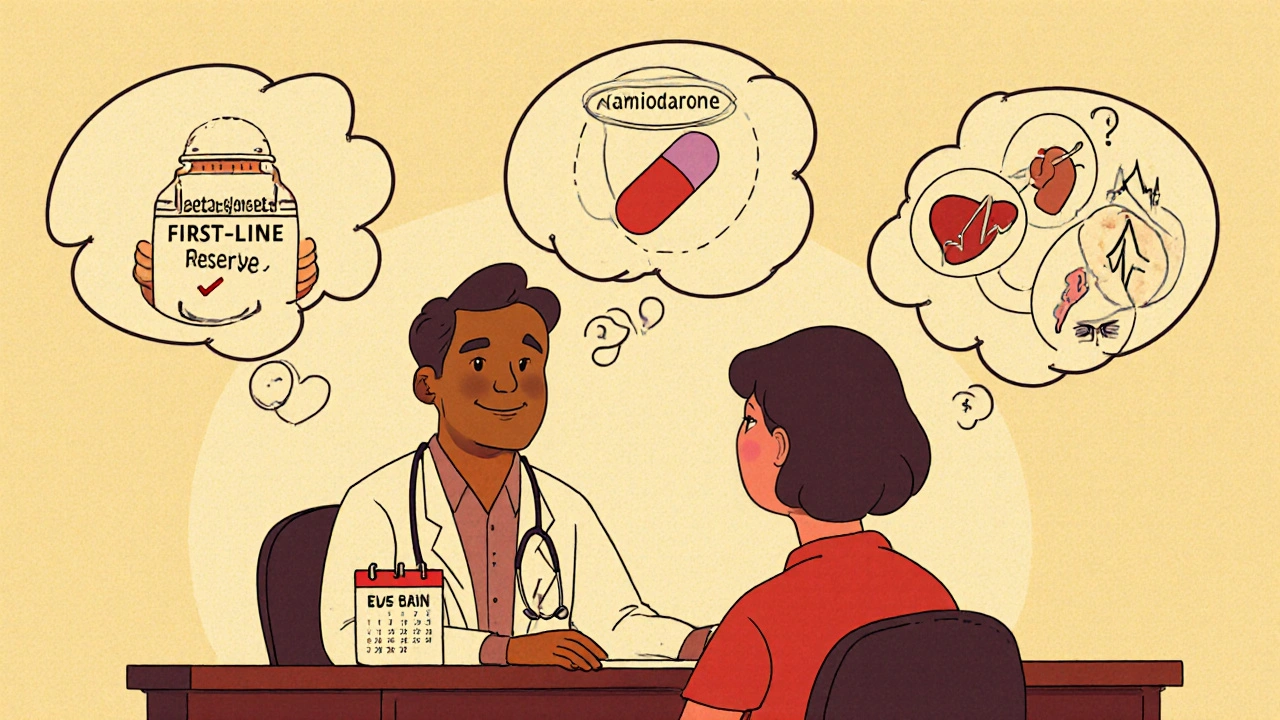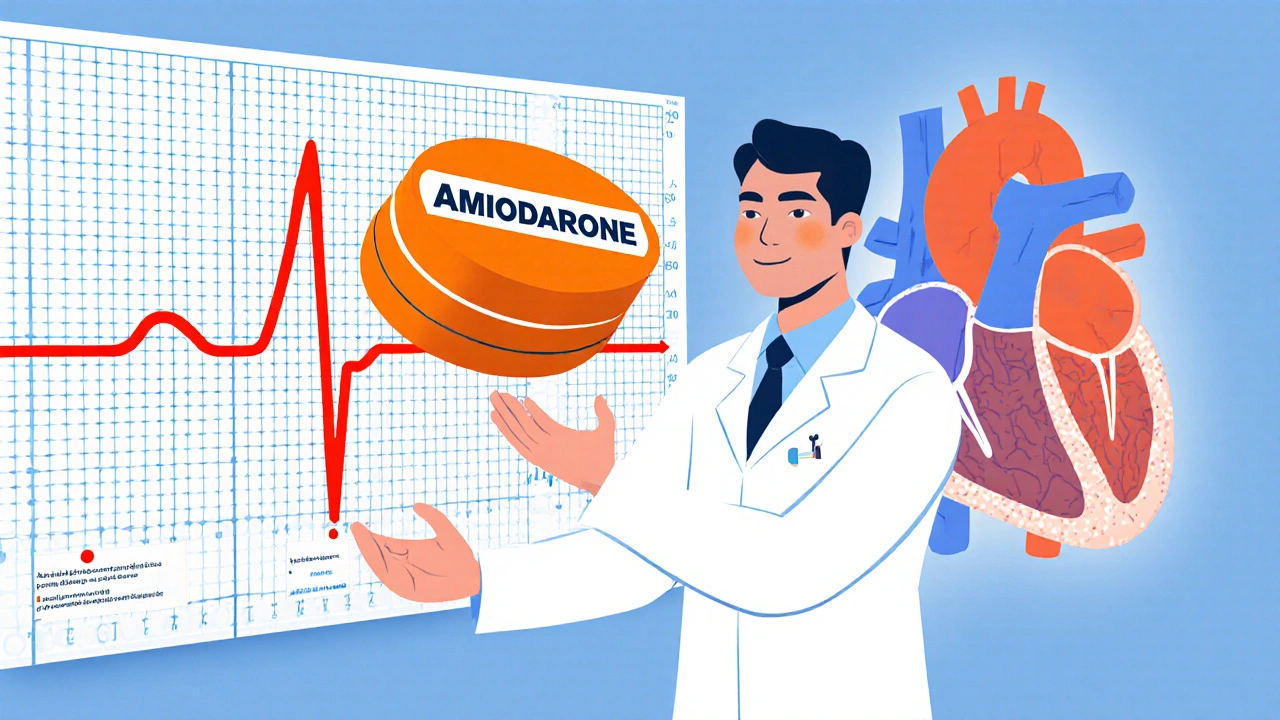QT Interval Calculator for LQTS Patients
QT Interval Assessment Tool
Calculate corrected QT interval (QTc) and assess safety for Long QT Syndrome patients considering amiodarone therapy
Results will appear here after calculation
Key Takeaways
- Amiodarone can stabilize heart rhythm but may worsen QT prolongation in susceptible patients.
- Long QT Syndrome (LQTS) requires careful drug selection, routine ECG monitoring, and risk‑factor management.
- Guidelines recommend beta‑blockers as first‑line therapy; amiodarone is reserved for refractory ventricular arrhythmias.
- Regular assessment of thyroid, liver, and pulmonary function is essential when using amiodarone long‑term.
- Understanding drug‑induced QT changes helps clinicians balance efficacy and safety.
What Is Amiodarone?
Amiodarone is a class III antiarrhythmic medication that blocks potassium channels, slows heart conduction, and prolongs the refractory period of cardiac tissue. It was first approved in the 1970s and is widely used for ventricular tachycardia, atrial fibrillation, and heart‑failure‑related arrhythmias. Its broad spectrum of action comes with a long half‑life (up to 100 days) and a high potential for organ toxicity.
Understanding Long QT Syndrome
Long QT Syndrome is a hereditary or acquired disorder characterized by a prolonged QT interval on the electrocardiogram, increasing the risk of torsades de pointes and sudden cardiac death. The condition can be congenital (mutations in KCNQ1, KCNH2, SCN5A genes) or drug‑induced. Typical QTc values exceed 450ms in men and 470ms in women.
The heart’s electrical cycle is measured by the QT interval, which represents the time from ventricular depolarization to repolarization. When this interval stretches, the myocardium becomes vulnerable to chaotic re‑entry rhythms.
How Amiodarone Affects the QT Interval
Amiodarone’s potassium‑channel blockade inherently lengthens the QT interval, yet it rarely triggers torsades de pointes compared with pure class III drugs like sotalol. The reason lies in its multichannel effects: it also blocks sodium and calcium channels, providing a stabilizing influence that dampens early after‑depolarizations.
In patients with LQTS, adding amiodarone can push the QTc into dangerous territory, especially if they are already on other QT‑prolonging agents, have electrolyte imbalances, or suffer from structural heart disease. Therefore, clinicians must weigh the antiarrhythmic benefit against the potential for further QT extension.
Guideline‑Based Management of LQTS
Current consensus from the American Heart Association (AHA) and European Society of Cardiology (ESC) emphasizes:
- Beta‑blocker therapy as first‑line for most LQTS genotypes.
- Removal of QT‑prolonging drugs whenever possible.
- Electrolyte optimization (maintain potassium >4.0mmol/L, magnesium >2.0mg/dL).
- Device implantation (ICD) for high‑risk patients with documented ventricular arrhythmias.
- Consideration of left cardiac sympathetic denervation for refractory cases.
Amiodarone enters the picture only when ventricular tachycardia or fibrillation persists despite beta‑blockade, ICD therapy, or when the rhythm is hemodynamically unstable.
When to Use Amiodarone in LQTS
Situations where amiodarone may be justified include:
- Refractory ventricular tachycardia unresponsive to acute cardioversion.
- Atrial fibrillation with rapid ventricular response that cannot be controlled by rate‑limiting drugs.
- Patients awaiting definitive device implantation who need immediate rhythm control.
Even in these cases, a loading dose (e.g., 150mg IV over 10minutes followed by 1mg/min for 6hours) is followed by a maintenance infusion (0.5mg/min) and then transition to oral therapy (200mg daily). Baseline and serial ECGs are mandatory to track QTc.
Monitoring and Safety Checks
Because amiodarone accumulates in fatty tissue, toxicity can emerge months after initiation. A practical monitoring schedule includes:
| Parameter | Baseline | 1‑Month | 3‑Months | Every 6Months |
|---|---|---|---|---|
| QTc (ECG) | Yes | Yes | Yes | Yes |
| Thyroid function (TSH, Free T4) | Yes | Yes | Yes | Yes |
| Liver enzymes (ALT, AST) | Yes | Yes | Yes | Yes |
| Pulmonary function (CXR, PFT) | Yes | Yes | Yes | Yes |
| Renal function (eGFR) | Yes | Yes | Yes | Yes |
Any sudden increase in QTc >30ms or new Torsades de Pointes mandates immediate drug cessation and magnesium infusion.

Comparing Amiodarone to Other Antiarrhythmics in LQTS
| Drug | Class | Effect on QT | Typical Indication | Major Risks |
|---|---|---|---|---|
| Amiodarone | III (multichannel) | Moderate prolongation | Refractory VT/VF, AF | Thyroid, pulmonary, hepatic toxicity |
| Sotalol | III | Significant prolongation | AF, VT | Pro‑arrhythmia, renal clearance issues |
| Mexiletine | IB | Minimal effect | LQT3-specific therapy | Neurologic tremor, GI upset |
| Beta‑blocker (e.g., nadolol) | None (rate control) | No prolongation | First‑line LQTS | Bradycardia, fatigue |
| Flecainide | IC | Variable | Rarely used in LQTS | Pro‑arrhythmia in structural disease |
The table highlights why amiodarone is a second‑line choice: its multichannel profile reduces torsades risk, yet its organ toxicity profile restricts long‑term use.
Practical Tips for Clinicians
- Always obtain a baseline QTc before starting amiodarone.
- Correct hypokalemia and hypomagnesemia before drug initiation.
- Prefer low‑dose oral regimens once the acute phase is managed.
- Educate patients about visual changes (corneal deposits) and pulmonary symptoms.
- Document all concurrent QT‑prolonging medications and adjust doses accordingly.
Frequently Asked Questions
Can amiodarone cause sudden cardiac death in LQTS patients?
Amiodarone itself rarely triggers torsades de pointes, but if the QTc exceeds 500ms or if it’s combined with other QT‑prolonging drugs, the risk rises. Close ECG monitoring mitigates this danger.
How long does it take for amiodarone to reach steady‑state levels?
Because of its long half‑life, steady state is usually achieved after 4-6weeks of consistent dosing.
Is it safe to switch from sotalol to amiodarone in a patient with LQTS?
A gradual cross‑taper is recommended. Stop sotalol, wait for QT normalization, then introduce amiodarone at a low dose while monitoring QTc daily for the first week.
What are the most common side effects of long‑term amiodarone therapy?
Thyroid dysfunction (both hypo‑ and hyper‑), pulmonary fibrosis, hepatic enzyme elevation, corneal micro‑deposits, and skin photosensitivity are the most frequently reported.
Should patients with congenital LQTS avoid amiodarone altogether?
Not absolutely. If life‑threatening ventricular arrhythmias occur and other therapies fail, amiodarone can be used under strict supervision.








6 Comments
Dervla Rooney
October 15, 2025 AT 13:06Amiodarone’s utility in refractory ventricular arrhythmias is well‑documented, yet its impact on the QT interval warrants careful consideration, especially in patients with congenital Long QT Syndrome. The drug’s multichannel blockade can mitigate torsades risk compared with pure class III agents, but clinicians must still monitor QTc closely after each dose adjustment. Baseline electrolyte correction-potassium above 4.0 mmol/L and magnesium above 2.0 mg/dL-remains a cornerstone of safe initiation. Moreover, routine thyroid and hepatic panels should be scheduled at one‑month, three‑months, and six‑month intervals to detect early toxicity. By integrating these safeguards, the benefits of rhythm control can be achieved without compromising patient safety.
Johnny Ha
October 29, 2025 AT 09:26Look, the pharma giants push amiodarone like it’s a miracle cure, but nobody tells you how it sits in your fat and leaks into every organ. You’re basically signing up for a lifetime of thyroid drama and lung scarring while they brag about “multichannel effects.” If you’re smart, you’ll stay away from the big‑label pills and ask why the FDA lets this stuff stay on the market. It’s all a big money‑making scheme, and the only real protection is knowing the risks and saying “no thanks.”
Mary Cautionary
November 11, 2025 AT 03:00While your enthusiasm for alternative narratives is noted, it is incumbent upon us to reference the peer‑reviewed consensus that delineates amiodarone’s risk‑benefit profile. The literature, including the ESC and AHA guidelines, unequivocally positions beta‑blockade as first‑line therapy for LQTS, reserving amiodarone for truly refractory cases under stringent monitoring protocols. Dismissing these recommendations as mere conspiratorial rhetoric undermines the cumulative expertise of cardiology specialists worldwide. A balanced appraisal, grounded in evidence‑based medicine, remains the most judicious approach.
Crystal Newgen
November 23, 2025 AT 06:40Just to add a practical note, when I’ve had to start amiodarone in a LQTS patient, I make sure we get a solid ECG baseline and then repeat the QTc after the loading dose. It helps to keep an eye on any sudden jump over 500 ms. Also, coordinating with the pharmacy for drug‑interaction checks can catch hidden QT‑prolongers that might otherwise slip through.
Hannah Dawson
December 4, 2025 AT 20:26Speaking of hidden interactions, many clinicians overlook the synergistic effect of over‑the‑counter antihistamines and certain antibiotics that can amplify amiodarone’s QT‑prolonging potential. In my experience, a simple checklist that flags ANY medication with a known QT impact cuts down adverse events dramatically. It’s not enough to scan the primary cardiac meds; you have to audit the entire med list, including supplements like magnesium oxide, which paradoxically can be formulated with potassium‑binding agents that destabilize electrolytes.
Julie Gray
December 15, 2025 AT 06:26It is imperative to recognize that the regulatory agencies have historically downplayed the long‑term pulmonary toxicity associated with amiodarone, classifying it as a “rare” side effect despite mounting post‑marketing surveillance data indicating a significant incidence. This systematic minimization serves commercial interests, allowing continued widespread prescription without adequate patient counseling on the risk of fibrosis.